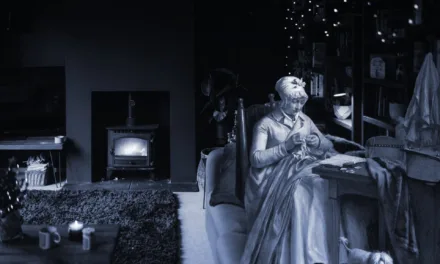
How do you describe indoor spaces?

“I struggle with describing interior scenes in my writing. I can visualize the spaces perfectly in my head, but when I try to put them on the page, it feels flat or like I’m just listing furniture. How do I make indoor spaces feel alive and immersive?”
A lot of what we see, we take for granted. Our eyes take in a huge amount of information all at once, send that information to our brains, and we just understand it! We don’t often think about the details; we just take them in passively and let our brains sort out what’s relevant and what’s not.
If you have a visual memory (not everyone does), it’s relatively simple to recall an image. But it’s a lot more difficult to recall it and then really pull out the details. Translating what we see in our mind’s eye into words that capture atmosphere and feeling can be frustratingly difficult. It’s not just about what you want readers to imagine, but what you want them to feel. And that’s a different skill from just providing an inventory of visual elements. So how can you develop that skill?
Go beyond the visual
One of the biggest mistakes we make when describing interior scenes is relying too heavily on what things look like. While visual details matter, they’re just one piece of the puzzle. We don’t just experience the spaces we inhabit with sight; there are other senses that also contribute to the experience. For instance:
- Smell: The scent of cleaning products, cooking aromas, mustiness, fresh paint, or even the absence of smell in a sterile environment can give a reader a clear sense of how they should interpret the space.
- Sound: The echo in an empty room, the hum of appliances, creaking floorboards, muffled conversations from another room, or oppressive silence all contribute to the general vibe.
- Temperature and texture: The chill of tile floors, warmth from a fireplace, the sticky feeling of humidity, or the softness of worn upholstery under fingertips all contribute not only to the space itself, but to how the character feels physically within it.
- Taste: Sometimes indoor spaces have tastes, like the metallic tang of old pipes, dust in the air, or lingering flavours from cooking. Sometimes the best description is to combine two senses to describe something, for instance, the air smelling sweet, like spiced rum.
Show activities, not just architecture
An often-missed opportunity is to look at an indoor space as more than the sum of its parts. A space is not static, and often what brings it to life is what happens within it. Instead of just describing the granite countertops of the stainless steel appliances of a kitchen, you can show someone actively cooking there. It allows readers to experience the space through action.
Think about:
- What do people do in this space regularly?
- What routines and rituals define it?
- How does the space help or hinder movement?
- Are there any signs of life, like dishes in the sink, books left open, coats thrown over chairs?
- Are the normal signs of actively absent (e.g. an unused nursery, a locked office, an abandoned mall)?
A bedroom isn’t just a bed, nightstand, and dresser. It’s where someone lies awake worrying, where they dress for important meetings, where they keep their treasured possessions, and where clothes pile up on a chair throughout the week.
Layer your descriptions
Don’t feel pressured to describe everything at once. Interior descriptions work best when woven naturally throughout a scene rather than front-loaded when first introduced.
Instead, try these approaches:
- As your character walks through a room, they naturally notice different things, which will allow you to reveal them naturally.
- Connect descriptions to your character’s emotions. A nervous character, for instance, might fixate on how the walls feel close and restrictive, while a relaxed one might notice comfortable details like bright colours, or birdsong outside.
- Compare the space to other spaces your character knows intimately. Is it warmer, cleaner, more cluttered, surprisingly modern?
- Different characters notice different details based on their backgrounds, professions, and personalities, so you can filter descriptions of the space through your characters’ experiences.
Make it matter to your story
Every interior description should serve a purpose beyond simply establishing setting. Like any element of writing, if it’s not relevant, don’t describe it too much. If a character is simply passing through the kitchen to get to the garden, then naming the room is enough. The reader doesn’t need every detail because it isn’t relevant or important to the scene that’s happening.
Ask yourself:
- Does this space reflect something about the character who inhabits it?
- Does the atmosphere support the mood of the scene?
- Are there details here that will become relevant later?
- Does this setting contrast meaningfully with other locations in your story?
- What does this space reveal about the world or time period?
A detective might notice security features and exit routes. An interior designer would clock furniture styles and colour schemes. A child would focus on whether there are toys or treats. Let your character’s perspective shape what gets described, but only if it’s relevant to their experience of it.
Common pitfalls to avoid
- Don’t let your description turn into a furniture catalogue. Not every item in a room needs to be described. Only what is relevant.
- Don’t front-load a scene with too much description before anything happens.
- Don’t rely exclusively on visual details. Remember to use all the senses in your descriptions.
- If you’re describing a space, avoid using clichés or vague terms that could apply to any space. If it’s not clear, it’s probably not relevant.
- Don’t ignore lighting. Light transforms interior spaces dramatically. The harsh fluorescence of an office, golden afternoon sun through lace curtains, the blue glow of a television in a dark room, or flickering candlelight all create completely different atmospheres in the same space.
The key to describing interior spaces is remembering that they’re not just backdrops. Setting can be an extension of character, contribute to your story’s theme and mood, and even serve as active elements in your story. Readers don’t need exhaustive blueprints. They just need enough sensory detail and atmosphere to inhabit the space alongside your characters.
































